Interpreting Your Auto'S Alert Lighting: Their Real Ramifications
Interpreting Your Auto'S Alert Lighting: Their Real Ramifications
Blog Article
Post Developed By-Higgins Corbett
When you lag the wheel, those beautiful caution lights on your control panel can be a little bit difficult. Do you understand what they're attempting to tell you regarding your auto's health and wellness? Comprehending the relevance of these lights is essential for your safety and the long life of your vehicle. So, tesla ceramic of those lights appears, would not you want to understand its message precisely and take the necessary actions to address it?
Common Warning Lights and Interpretations
Recognize typical caution lights in your vehicle and recognize their meanings to make sure safe driving.
One of the most normal caution lights include the check engine light, which indicates issues with the engine or emissions system. If this light comes on, it's essential to have your vehicle inspected without delay.
The oil pressure cautioning light shows reduced oil pressure, calling for instant interest to prevent engine damages.
A blinking battery light could recommend a defective billing system, potentially leaving you stranded if not addressed.
The tire pressure surveillance system (TPMS) light alerts you to low tire stress, impacting car security and fuel effectiveness. Neglecting this can result in hazardous driving conditions.
The abdominal light suggests a problem with the anti-lock stopping system, endangering your capacity to stop swiftly in emergencies.
Finally, mouse click the following web page alerting light warns of engine getting too hot, which can cause severe damages otherwise resolved swiftly.
Recognizing these usual warning lights will aid you attend to problems quickly and keep safe driving conditions.
Significance of Prompt Focus
Recognizing the typical warning lights in your vehicle is just the initial step; the relevance of immediately attending to these cautions can't be highlighted enough to ensure your security on the road.
When a caution light brightens on your control panel, it's your automobile's means of connecting a possible concern that needs focus. Overlooking these warnings can cause much more serious issues down the road, jeopardizing your safety and potentially costing you much more out of commission.
car cleaning upholstery to cautioning lights can prevent breakdowns and crashes. For example, a flashing check engine light can show a misfire that, if left neglected, might create damages to the catalytic converter. Resolving this immediately can save you from a costly repair service.
In a similar way, a brake system warning light may signify low brake liquid or used brake pads, critical parts for your security when driving.
Do It Yourself Troubleshooting Tips
If you discover a caution light on your dashboard, there are a few do it yourself fixing ideas you can attempt before looking for professional help.
The initial step is to consult your cars and truck's manual to recognize what the details warning light indicates. Occasionally the problem can be as easy as a loose gas cap triggering the check engine light. Tightening the gas cap may fix the problem.
https://brakesplus51739.howeweb.com/31801016/curious-about-those-dashboard-caution-lights-in-your-car-figure-out-what-they-suggest-for-your-car-s-health-and-wellness is a low battery, which can set off various warning lights. Inspecting the battery connections for rust and guaranteeing they're safe could deal with the problem.
If a warning light continues, you can try resetting it by disconnecting the auto's battery for a few minutes and afterwards reconnecting it. Furthermore, examining your car's fluid degrees, such as oil, coolant, and brake liquid, can aid repair advising lights associated with these systems.
Conclusion
To conclude, understanding your car's caution lights is essential for maintaining your lorry running efficiently and safely. By quickly dealing with these notifies and understanding what they indicate, you can stay clear of costly repairs and potential malfunctions.
Keep in mind to consult your vehicle's guidebook for particular details on each cautioning light and take action as necessary to make sure a hassle-free driving experience.
Stay educated, stay risk-free when traveling!
